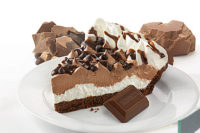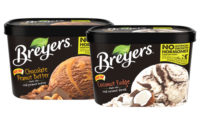The shelves are crowded in the frozen and refrigerated dessert cases at the grocery store. Not only do manufacturers of pies, cheesecakes and puddings have to deal with competition from each other, but ice cream, frozen yogurt, frozen novelties and even dessert-style yogurts are all competition. The companies also have to find a way to appeal to a consumer base that’s becoming hyperaware of what’s in their food and what they’re willing to put in their bodies.
In the refrigerated desserts category, dollar sales were up 2.8% to $673.5 million, while unit sales were almost at a standstill — up 0.1% to 300.1 million, according to Information Resources Inc. (IRI), Chicago, for the 52 weeks ended June 12, 2016. The numbers for the frozen desserts/toppings category were less promising, with dollar sales up 0.7% to $692.4 million, while unit sales dropped 3.1% to 278.1 million. The ice cream/sherbet category’s dollar sales, as mentioned above, were a bit more promising — dollar sales were up 2.8% to $6.4 billion and unit sales increased 2.5% to 1.7 billion. See a more detailed look of what’s happening in frozen dessert sales.
A nutritional focus
With health and clean ingredients remaining top-of-mind for many consumers, some are ditching regular ice cream or pudding in favor of dessert-flavored yogurts or healthier versions of ice cream. Ice cream-style products which tout claims like lactose-free, gluten-free, non-GMO and high-protein are on the rise. Some of these same products are being packed with vitamins and probiotics. These innovations offer another option for those focused on weight management, health or who have dietary restrictions — while still being able to enjoy a sweet treat.
But consumers can still be picky — taste matters.
“Consumers are looking for healthier options, even in their frozen desserts,” said Karen Moyer, vice president of marketing at Arctic Zero, Escondido, Calif. “But it’s important to note that people first want to enjoy their dessert. If you can deliver eating enjoyment along with better nutrition, that’s the winning combination. We don’t believe that merely adding functional ingredients will make people choose one dessert over another — particularly if it creates a compromise in taste or experience.”
Arctic Zero, which dubs its low-calorie and lactose-free frozen treat as “fit frozen desserts,” recently conducted a national survey online. The survey revealed that 14% of Americans avoid traditional ice cream because they are trying to lose weight or stay fit. And 30% say they like ice cream, but limit their intake because they don’t feel it’s a healthy choice. Dietary restrictions (the most common being low-sugar diets due to diabetes or other reasons, and lactose intolerance), prevent another 10% from eating ice cream.
Ingredients also really matter. The survey showed that 45% of Americans either always or frequently check nutrition labels on their frozen desserts before buying or consuming them — and more than half (51%) have changed their minds about eating a product based on what they saw there. According to the survey, these are the top five attributes Americans want in a healthier ice cream: low in sugar, low-calorie, low- or nonfat, free of artificial sweeteners, free of artificial flavors and colors.
The largest ice cream makers have cleaned up their ingredient decks. Nestlé Dreyer’s Ice Cream, Oakland, Calif., made ingredient improvements to six of its brands: Häagen-Dazs, Outshine, Skinny Cow, Nestlé Ice Cream and Nestlé Drumstick. The company removed artificial colors and flavors, high fructose corn syrup and GMO ingredients from more than 100 products. It is also using rBST-free milk and real fruit or fruit juice, and reduced sugar by 11% for select products.
Arctic Zero sweetens its products with monk fruit, a natural sweetener, which consumers rank much higher on the acceptance scale, according Moyer. This year, Arctic Zero released seven new products –five new pint flavors and two new chocolate-dipped bars. Its newest chunky flavors of the 300-calorie pints are Brownie Blast, Snickerdoodle Dandy and Banana Pudding. The creamy flavors of its 150-calorie pints are Cake Batter and Poppin’ Pomegranate. The company also added salted caramel and mint flavors to its 80-calorie chocolate-dipped bars.
“From clean ingredient statements to gluten free to vegan, the focus on the ingredients permeates throughout the food chain from grower to manufacturer to distributor to retailer to consumer,” said Debbie Marchok, vice president of marketing for Eli’s Cheesecake, Chicago.
Eli’s Cheesecake recently introduced a chocolate hazelnut cheesecake made with gluten-free ingredients to meet the lifestyle needs of that growing niche of consumers, and a cookie butter cheesecake made with GMO-free ingredients.
Manufacturers say the meaning of “healthy” or “better-for-you” has expanded. Consumers seek nutrient-dense desserts and treats.
“Until recently, claims of “low-fat” and “fewer calories” were the main attributes that made a product healthy, but now there’s a focus on getting more nutrition from every calorie you consume,” said Arnie Koss, co-founder of Brio Ice Cream, owned by Nutricopia Inc., Montpelier, Vt. “Shoppers aren’t looking for low-fat and empty calories. They want products offering more protein, smart fats, nutritive sweeteners (for energy), balanced omegas and probiotics. They are also seeking products that are certified gluten-free, non-GMO and made with organic ingredients.”
Koss added, “Look at snack and dessert products in the marketplace and you’ll see a clear move towards better-for-you foods with more nutritional value. Consumers have learned about — and embraced — the value of antioxidants, the need for protein, the importance of healthy fats (instead of nonfat), the value of organic whole milk from pasture-raised cows and recently, the importance of gut health and the benefits of probiotics and prebiotics.”
Brio Ice Cream touts many of these health claims right on its packaging, including pasture-raised, made with organic whole milk and non-GMO. The dessert’s ingredient list includes organic whole milk, natural fructose, organic agave nectar, organic coconut oil and probiotics. It also contains several vitamins and minerals, including vitamin A, C, D, B12 and B6. The desserts come in six flavors, including strawberry, vanilla caramel, dark chocolate and Madagascar vanilla. A 3.6-ounce cup of the dark chocolate flavor contains 135 calories, 6 grams of fat, 13 grams of sugar and 5 grams of protein.
“In the past few years, we’ve seen the frozen dessert aisle shift from diet-focused offerings to ‘better-for-you’ products that deliver with great-tasting flavors,” said Drew Harrington co-founder, co-CEO for Yasso Frozen Greek Yogurt, Quincy, Mass.
Yasso launched in 2011 and as Harrington put it, “Clean ingredients helped us differentiate ourselves in the market from the beginning.”
Its frozen Greek yogurt bars are high in protein, low in calories and are made with Greek yogurt processed from rBST-free milk, and natural ingredients like cocoa. The cookies n’ cream flavor contains 100 calories, 2 grams of fat, 13 grams of sugar and 5 grams of protein per bar. Yasso has expanded its lineup to 13 bar flavors, including cookies n’ cream, chocolate chip and Cinnamon Bun. The Cinnamon Bun flavor won the company third place for the Most Innovative Ice Cream Novelty at the Ice Cream Technology Conference, put on by the International Dairy Foods Association last spring.
For Yasso, it’s just as much about taste and flavors as it is about a healthier option.
“We analyze trends within frozen and beyond, and utilize sales data, consumer surveys and fan feedback to gather insights on what could be the next big flavor or form for us,” said Harrington.
Many consumers are looking for vegan and gluten-free desserts, said Reuben BenJehuda, a founder of New York, N.Y.-based Popbar, which handcrafts gelato on a stick, that’s customizable and made with all-natural ingredients.
He said these trends have helped with the popularity of Popbar shops, because the treats are low in calories, gluten-free and many of the popbars like popSorbetto in particular, are vegan. He added that all of the company’s gelato is made fresh in house (at every shop), with only natural ingredients (like real fruit), and contains no artificial flavorings, colors or preservatives.
The company also stands out for its use of unique flavors, such as green tea gelato dipped in white chocolate and crushed waffle cone pieces, dulce de leche dipped in caramel corn, tiramisu and Irish coffee.
Convenience drives innovation
Innovations in frozen desserts have helped generate consumer interest, according to Chicago-based Euromonitor International. One important area of innovation in this category is pack size as manufacturers introduce new options which appeal to all consumer types. Single-serve products, for example, provide indulgent options that also meet consumer demand for convenience and portion-control. As a result, products like Bloomington, Minn.-based Edwards’ single and 2-pack pie slices have contributed to the strong growth for that brand in recent years, said Euromonitor.
“One of the trends we are seeing is an interest in single-serves (for easier serving and portion-control, as well as for on-the-go snacking),” said Koss. “We have become a nation of snackers. We want convenient, delicious snacks, and are also concerned with being healthy and fit.”
Brio Ice Cream offers its frozen dessert in two sizes — a 14-ounce container and a 3.6-ounce cup (single-serve) for
portion control. The company created the single-serve version with a built-in spoon for convenient on-the-go snacking.
“Desserts are a treat and consumers look forward to indulging by monitoring the portion size,” said Marchok of Eli’s Cheesecake. “The novelty and visual appeal of miniatures falls right in line. The popularity of our mini pies and ‘cuties,’ our version of mini dessert bars and cheesecakes, continues to grow in the marketplace.”
The company also introduced 3-inch tarts made with an all-butter pâte sucrée crust last spring (in bulk for in-store bakery and foodservice) in four varieties: salted caramel (made with caramel and chocolate ganache), lemon, cheesecake and butter (a chewy tart made with butter, brown sugar and eggs.) Individually wrapped versions of the butter and salted caramel are available this month for in-store bakeries and foodservice at a suggested retail price of $2.69.
Flavor innovation and food mash-ups
Flavor innovation and interesting food combinations are another driving force in this market.
“Food mash-ups and innovative ways to eat ice cream continue to be two hot trends that we’ve been watching closely,” said Jeanne Bolger, director, Research & Development, Baskin-Robbins, Canton, Mass.
The company introduced what Bolger calls “fun” new desserts this year, including Polar Pizza, which is an ice cream treat that can be eaten like a pizza. The pizza is available in four flavor combinations, including peanut butter chocolate and Reese’s peanut butter cup. Also, warm cookie ice cream sandwiches, which feature an ice cream flavor of choice sandwiched between two warmed-to-order, cookies; and new doughnut ice cream sandwiches, which feature an ice cream flavor of choice topped with hot fudge and sandwiched in a sliced, powdered sugar doughnut.
“Flavors that are out of the box and turning high-demand treats such as cookie and candy brands into ice cream flavors,” is a popular trend, said Scott Colwell, president of Carvel, Atlanta.
Carvel has capitalized on this idea by offering frozen treats and soft ice cream featuring Nutella, Ghirardelli and Oreo in its shops.
Though ice cream remains the most popular among frozen desserts, there’s room for others in the frozen and refrigerated space to makes their mark with the right kind of innovation, size offerings and flavor exploration.











